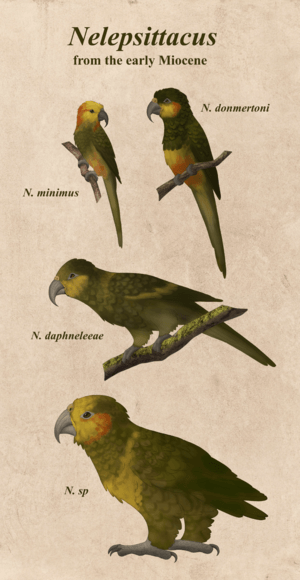Nelepsittacus facts for kids
Quick facts for kids Nelepsittacus |
|
|---|---|
 |
|
| Scientific classification |
|
| Kingdom: | Animalia |
| Phylum: | Chordata |
| Class: | Aves |
| Order: | Psittaciformes |
| Family: | Strigopidae |
| Genus: | †Nelepsittacus Worthy, Tennyson, Scoffeld 2011 |
| Species | |
|
N. daphneleeae |
|
Nelepsittacus was a type of New Zealand parrot that is now extinct. These ancient parrots were closely related to today's Nestor parrots, which include the kaka and kea. Scientists have found fossils of four different Nelepsittacus species, and three of them have been given names. All these fossils come from a place in Otago, New Zealand, called the Saint Bathans Fauna, which dates back to the early Miocene period. This area was once a subtropical rainforest.
Scientists can tell that Nelepsittacus parrots are related to Nestor parrots by looking at their skeletons. They share special features in bones like the shoulder bone (coracoid), upper arm bone (humerus), and leg bones (tibiotarsus and tarsometatarsus). These features are only found in Nelepsittacus and Nestor parrots.
The area where these fossils were found, called the Saint Bathans fauna fossil beds, shows that these parrots lived in a warm, wet subtropical rainforest. After the early to mid-Miocene period, the temperature dropped. This change in climate caused many local plants and animals to disappear. The loss of native Nelepsittacus parrots likely allowed Cyanoramphus parrots to thrive. These parrots were newer to the area, having migrated from the southwest Pacific.
The largest known fossil parrot species, Heracles inexpectatus, was discovered in 2019. Its bones were also found in the early Miocene St Bathans fauna. The name Heracles was chosen because of a Greek myth. In this story, the hero Heracles killed King Neleus. This name choice shows the connection between the two parrot genera.
Contents
Discovery and Naming
The parrots of the Nelepsittacus genus were first described by Trevor H. Worthy in 2007. Most of the fossils of these parrots were found along the banks of the Manuherikia River in Otago, New Zealand.
The genus was named after Neleus, a figure from Greek mythology. Neleus was the father of Nestor. This naming reflects the close relationship between the extinct Nelepsittacus genus and the living Nestor parrots.
Species of Nelepsittacus
(Listed in order of when they were described)
Nelepsittacus minimus
N. minimus is the first species described and the smallest of the three (or possibly four) known Nelepsittacus parrots. Its name, "minimus," means "smallest."
Nelepsittacus donmertoni
Nelepsittacus donmertoni is the next-smallest species. Its bones show it was about the same size as the crimson rosella (Platycercus elegans), a parrot found in eastern Australia. The lower jawbones (mandibles) of N. donmertoni are more similar to those of the kakapo (Strigops) than to Nestor parrots.
This species was named to honor the late Don Merton. He was very important in helping to save the kakapo from extinction.
Nelepsittacus daphneleeae
N. daphneleeae is about a quarter larger than N. donmertoni. Its upper arm bone (humerus) and forearm bone (ulna) suggest it was a little bigger than the Australian king parrot (Alisterus scapularis). However, it was a bit smaller than a galah (Eolophus roseicapillus). While it shares many bone similarities with the other two species, N. daphneleeae is only tentatively placed in the Nelepsittacus genus. This is because not enough of its lower leg bone (tarsometatarsus) has been found.
N. daphneleeae was named to honor geologist Daphne Lee. She contributed greatly to our understanding of New Zealand's land ecosystems during the Miocene period.
Nelepsittacus sp.
The last species, which has not yet been formally described, is known only from a left shoulder blade (scapula) and upper arm bone (humerus). This parrot was roughly the same size as a modern kea (Nestor notabilis).
Images for kids


